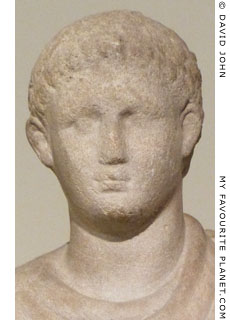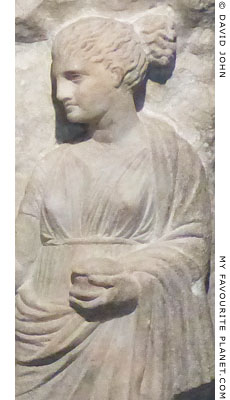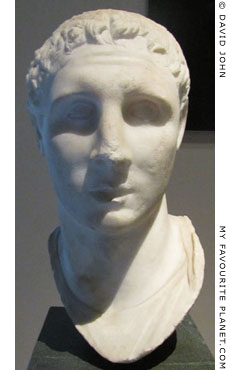Votive relief from Pella dedicated to Hephaistion by Diogenes, probably a veteran of Alexander the Great's army. The image of the high relief shows a young man with a horse and a young woman approaching each other. The man holds out a shallow bowl which the woman is about fill from a jug. In her left hand she holds a small, covered cylindrical container.
The type of image is similar to many other sculptures known from the ancient Greek, Thracian and Roman cultures representing heroic horsemen (see, for example, the photo below of a similar hero horseman relief from Thasos of the same period). Little is known for certain about the exact forms and rituals of hero worship, which varied from region to region. Some cults were particular types of ancestor worship specific to local families or tribes, while the worship of other legendary or mythical heroic warriors, chieftains and kings became more widespread. In some cases these heroes were elevated to gods or demi-gods, as in the case of Herakles (believed by several Greek tribes to be a founding ancestor) and Dioskouroi (Castor and Pollux).
The representations of heroes also varied greatly. Many images show one or two heroes riding or standing with horses, sometimes near a tree around which a snake is entwined and an altar. In others heroes are shown standing among worshippers or family members, sometimes with a groom or slave in attendance (see for example, the hero reliefs on Pergamon gallery 2, page 10).
In the latter type it often appears as if a wife or other family member is bidding farewell to the hero before he leaves on a long journey to war, his death and apotheosis. In the case of this relief from Pella, it seems as if the hero is returning from a long journey, or perhaps appearing to the woman in a dream or a vision.
Rituals including offering food and drink to the dead are very ancient, and are thought to have been practised in many cultures from at least Neolithic times. Libations and food offerings became standard in many cults in historic times, and are still part of the liturgies of many Christian denominations. These were real sacrifices - in the literal sense of giving away valuable resources such as food and drink - to the majority of people who were poor. Their symbolic value went beyond the transfer of these resources, as it was believed (and is still believed by Roman Catholics) that the offerings were supernaturally transformed so that they reached the spirit world in which the object of worship resided.
Other expensive sacrifices were also an important part of such cult rituals, and it has been suggested that the container held by the young woman in this relief held incense (even though the object looks more like a pie or a loaf). It seems to be taken for granted that the jug contained wine.
The relief has been identified as a dedication to Hephaistion, the companion of Alexander the Great, from the inscription along the foot of the marble stele (see photo below):
Διογένης Ἡφαιστίωνι ἥρωι
Diogenes to Hephaistion Hero
Inscription SEG 40:547.
This one of the few pieces of evidence discovered which appear to support accounts by ancient authors concerning the hero cult of Hephaistion.
Hephaistion (Ἡφαιστίων, circa 356-324 BC; his name is often written Hephaestion) was a Macedonian aristocrat, one of Alexander the Great's commanders and his closest friend. He is also said to have been Alexander's lover, although this is not mentioned by ancient authors. It is thought that they may have studied together at Aristotle's academy at Mieza.
During the long campaign through Asia, Alexander entrusted Hephaistion with several important military and diplomatic missions. At the mass wedding Alexander organized for Macedonian officers with Persian noblewomen at Susa in summer 324 BC, Hephaistion married Drypetis, a daughter of the defeated Persian King Darius III, while Alexander marrried her sister Barsine (Stateira).
However, a few months later he died at the Median city of Ecbatana, seven days after falling ill with a fever. Alexander grieved deeply for his friend and ordered an enormous and costly funeral pyre for him at Babylon, games including 3,000 competitors, as well as public mourning throughout Asia. Alexander's Companion cavalry, which Hephaistion had commanded, was named after him, many of its members dedicated themselves and their arms to him, and they carried an image of him at the front of their riding formation.
Alexander also sent an embassy to the oracle of Ammon at Siwa in Egypt to ask whether Hephaistion could be deified, as he himself had been during his visit there in 332 BC. When the oracle forbade this Alexander ordered that he should paid honours in perpetuity as a divine hero. Several shrines to him were built throughout Alexander's empire, including at Pella and Alexandria.
The hero cult for Hephaistion in Pella was probably established in accordance with Alexander's orders by Antipater, the regent in Macedonia during the king's absence. Professor Emmanuel Voutyras of Thessaloniki University believes there was a temple for the cult at Pella, to the north or west of the walled acropolis, possibly in a cave where the hero was offered worship and sacrifice as a means of communication with the underworld, in the hope of benefits such as healing. He also conjectures that the relief was made during the reign of Antipater's son Cassander (see History of Stageira part 6), and that Diogenes, who dedicated the relief, may have been one of the 10,000 soldiers who returned with Crateros to Macedonia from Persia. [1]
The question arises of whether the figure on the relief is meant to portray Hephaistion, and if so why is the image of such average quality? The scene has been described as "generic" and "standard" in terms of the iconography of hero reliefs, which may be due to the veteran's meagre budget, the political and economic conditions or the availability of good sculptors in Pella at the time it was made.
As Professor Voutyras points out, there is no ancient image that can be identified beyond doubt as a portrait of Hephaistion. The few surviving images thought to depict him (including a figure on the "Alexander Sarcophagus") were made some time after his death and may be idealized or generalized portraits.
In both the Pella relief and the Egyptian statue of Hephaistion in Athens (see photos right and below), the figure is beardless with short hair; the facial features are quite generalized, conforming to a Hellenistic type. As can be seen from comparing the statue of Alexander (photo below), thought to be from the same statue group, with other depictions of him (see Alexander the Great in our People section), the quality of the work is quite mediocre, indistinct and lifeless. In both sculptures the figures wear tunics gathered at the waist and riding cloaks typical of hero/horseman sculptures from Greece and Thrace. In the Egyptian statue Hephaistion wears high, open-toed boots, while in the Pella relief he is shown barefoot.
Other speculations concerning this stele include the suggestion that "Diogenes" refers to Alexander himself. The name Diogenes (Διογένης, born of Zeus) was used to refer to the king after his divinity had been confirmed by the oracle at Siwa. However, it has been pointed out that Diogenes was a common Greek name.
It is not known whether the female figure is meant to portray a specific individual or is a general representation of a worshipper. Her facial features are almost identical to those of the male figure. Notably, she is bareheaded with her hair tied back rather than veiled as in the case of many other hero monuments. |

Hephaistion in the Pella relief. |
| |

Detail of a marble statue
of Hephaistion from Egypt.
1st century BC. Perhaps from
a statue group in Alexandria
erected in his honour.
(see photos below)
National Archaeological Museum,
Athens. Egyptian Collection.
Inv. No. 45. |
| |

Detail of the female figure
in the Pella relief. |
| |

Marble head of a statue,
perhaps a portrait
of Hephaistion.
Late 3rd century BC. From
Kyme (Κύμη), Namurt, north of
Izmir, Turkey. Height 42.5 cm.
Istanbul Archaeological Museum.
Inv. No. 387 T. Cat. Mendel 599.
For further information,
see Alexander the Great
in the MFP People section. |
|